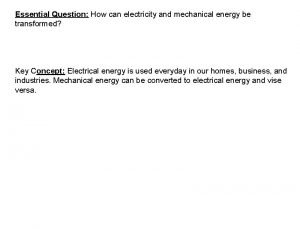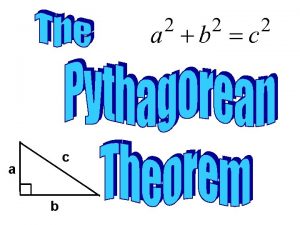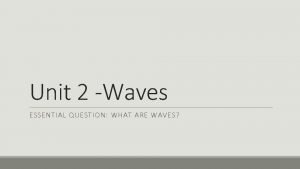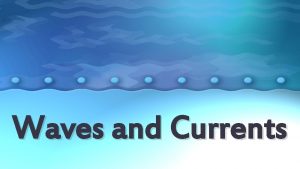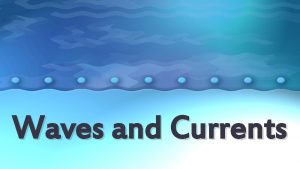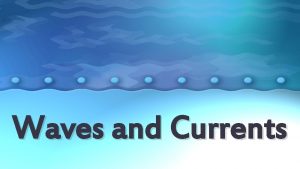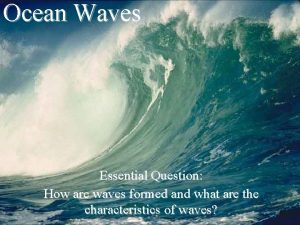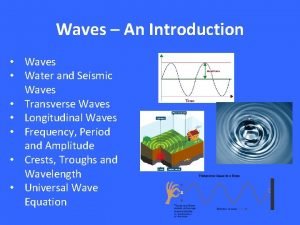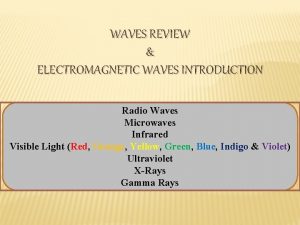Introduction to Waves Essential Question What are the






















- Slides: 22

Introduction to Waves Essential Question: What are the characteristics of mechanical and electromagnetic waves? (S 8 P 4 a, d, f)

What are Waves? Rhythmic disturbances that carry energy without carrying matter

Types of Waves • Mechanical Waves – need matter (or medium) to transfer energy • A medium is the substance through which a wave can travel. Ex. Air; water; particles; strings; solids; liquids; gases • Electromagnetic Waves – DO NOT NEED matter (or medium) to transfer energy • They do not need a medium, but they can go through matter (medium), such as air, water, and glass

Mechanical Waves that need matter (medium) to transfer energy: Examples: Sound waves, ocean waves, ripples in water, earthquakes, wave of people at a sporting event

Some examples of Mechanical Waves

Transverse (Mechanical) Waves • Energy causes the matter in the medium to move up and down or back and forth at right angles to the direction the wave travels. • Examples: waves in water • http: //www. stmary. ws/highschool/physics/home/notes/ waves/intro/video/Creating_a_Transverse_Wave. mov • http: //www. stmary. ws/highschool/physics/home/notes/ waves/intro/waves. Vibration. html

Parts of a Transverse Wave The crest is the highest point on a wave.

Parts of a Transverse Wave The trough is the valley between two waves, is the lowest point.

Parts of a Transverse Wave The wavelength is the horizontal distance, either between the crests or troughs of two consecutive waves.

Parts of a Transverse Wave The amplitude is the peak (greatest) value (either positive or negative) of a wave. The distance from the undisturbed level to the trough or crest.

An ocean wave is an example of a mechanical transverse wave


Compressional Wave (longitudinal) • A mechanical wave in which matter in the medium moves forward and backward along the same direction that the wave travels. • Ex. Sound waves A slinky is a good illustration of how a compressional wave moves

Parts of a Compressional Wave (Longitudinal) The compression is the part of the compressional wave where the particles are crowded together.

Parts of a Compressional Wave (Longitudinal) The rarefaction is the part of the compressional wave where the particles are spread apart.

Parts of a Compressional Wave (Longitudinal) The wavelength is the distance from compression to compression or rarefaction to rarefaction in a compressional wave.


Animation of Transverse and Longitudinal (Compression) Waves: http: //www. stmary. ws/highsch ool/physics/home/animations 3 /waves/wavemotion. html

Electromagnetic Waves that DO NOT NEED matter (medium) to transfer energy Examples: radiation, TV & radio waves, X-rays, microwaves, lasers, energy from the sun, visible light Electromagnetic waves are considered transverse waves because they have similar characteristics; therefore, they have the same parts. More to come on Electromagnetic waves…

Electromagnetic Spectrum The electromagnetic spectrum illustrates the range of wavelengths and frequencies of electromagnetic waves.

Electromagnetic Spectrum Sheet

Summarizing Strategy Types of Waves Quad Clusters
 Antigentest åre
Antigentest åre Costa questions level 2
Costa questions level 2 Characteristics of lipids
Characteristics of lipids Low amplitude wave
Low amplitude wave Sound waves are transverse waves true or false
Sound waves are transverse waves true or false Example mechanical waves
Example mechanical waves Difference between electromagnetic and mechanical waves
Difference between electromagnetic and mechanical waves The wave chapter 13
The wave chapter 13 Sound waves longitudinal waves
Sound waves longitudinal waves Carbon dioxide temperature
Carbon dioxide temperature Difference between matter waves and electromagnetic waves
Difference between matter waves and electromagnetic waves Examples of mechanical and electromagnetic waves
Examples of mechanical and electromagnetic waves Similarities of mechanical and electromagnetic waves
Similarities of mechanical and electromagnetic waves Surface waves and body waves
Surface waves and body waves Is a seismic wave mechanical or electromagnetic
Is a seismic wave mechanical or electromagnetic Compare and contrast p waves and s waves using venn diagram
Compare and contrast p waves and s waves using venn diagram Mechanical and electromagnetic waves venn diagram
Mechanical and electromagnetic waves venn diagram Constructive waves and destructive waves difference
Constructive waves and destructive waves difference Figurative language essential questions
Figurative language essential questions The pythagorean theorem
The pythagorean theorem Essential question generator
Essential question generator Essential questions for pythagorean theorem
Essential questions for pythagorean theorem Language
Language




















